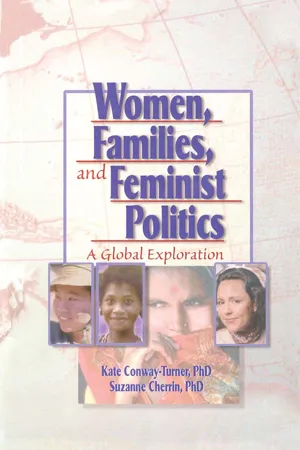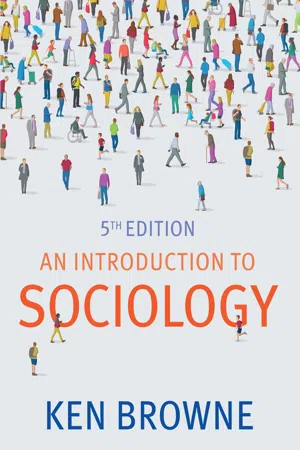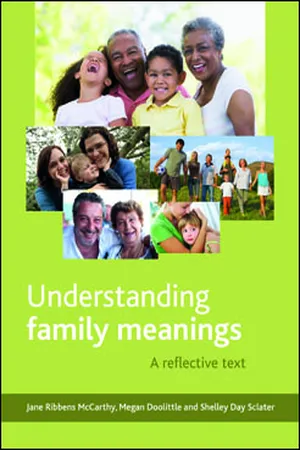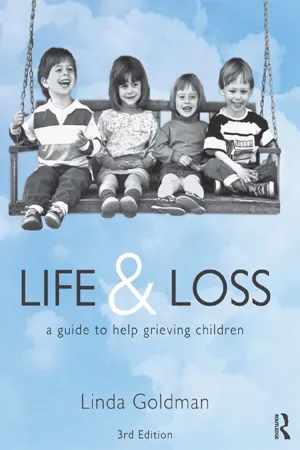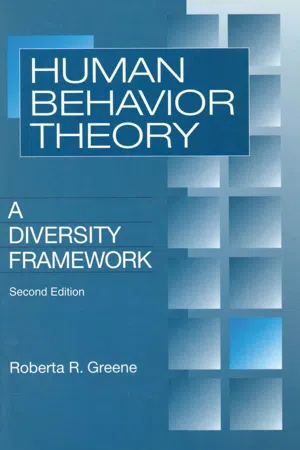Social Sciences
Family Diversity
Family diversity refers to the variety of family structures and dynamics present in society, including single-parent families, same-sex parent families, and blended families. This concept recognizes that families can take many different forms and that there is no one-size-fits-all model for what constitutes a family. Family diversity challenges traditional notions of family and highlights the importance of understanding and respecting different family configurations.
Written by Perlego with AI-assistance
Related key terms
Related key terms
1 of 4
Related key terms
1 of 3
7 Key excerpts on "Family Diversity"
- eBook - ePub
Women, Families, and Feminist Politics
A Global Exploration
- J Dianne Garner, Suzanne Cherrin(Authors)
- 2014(Publication Date)
- Routledge(Publisher)
Chapter 2Diversity Within Family Formation
Feminist thought broadens our notions of family to include the experiences of women from varied cultures, classes, and conditions. The language and much of the discourse concerning families has, until recently, reflected the view that monogamous, heterosexual, and nationalistic family formations are the only valid family forms. This perspective serves to negate the diverse reality of women worldwide. Many feminist writers have challenged this view and struggled to demystify the ideology of the monolithic family.1 This demystification has taken many forms as feminist scholars grapple with the diversity of women and the realities women face nationally and internationally. Some feminist theorists, however, are criticized for failing to centrally include women of color within analyses and for having a superficial understanding of the lives and families of women of color.2 Although the perspectives of contemporary feminist scholars include a recognition of the diversity of women's lives worldwide, some scholars challenge the depth of this knowledge. This chapter will explore the often neglected diversity among women's families and relationships across the globe.DEFINING FAMILIES
Most women throughout the world regard themselves as part of a family recognized by their community or peers. The forms these families take vary both within and between communities. In most communities, distinctly different family forms coexist. This chapter will explore the realities of family forms that women find themselves a part of around the globe. This discussion will not capture the intricacies of all families' alternative structures but will highlight those most commonly observed and examine how these forms explicate the realities of women's lives. - eBook - ePub
The Role of Gender in Practice Knowledge
Claiming Half the Human Experience
- Josefina Figueira McDonough, F. Ellen Netting, Ann Nichols Casebolt, Josefina Figueira McDonough, F. Ellen Netting, Ann Nichols Casebolt(Authors)
- 2018(Publication Date)
- Routledge(Publisher)
Unit One: Defining Family: Contested Terrain. A review of diverse understandings of family, and an introduction to concept of social construction.Selected Readings from: Thorne & Yalom (1982). Rethinking the family; Fine (1993). Current approaches to understanding Family Diversity; Gross (1992). Are families deteriorating or changing?; Flax (1982). The family in contemporary thought; Stacey (1990). Brave new families.Unit Two: Theorizing Family. A review and critique of dominant family theories in historical context.Selected Readings from: Burr et al. (1979). Contemporary theories about the family; Ingoldsby and Smith (1995). Families in multicultural perspective; Carter and McGoldrick (1989). The changing family life cycle; Cheal (1991). Family and the state of theory; Coates (1992). Ideology and education for social work practice; Ferree (1990). Beyond separate spheres.Unit Three: The Social Construction of Family: Cultural, Historical, and Political Perspectives.Selected Readings from: Gittens (1985). The family in question; Mintz and Kellogg (1988). Domestic revolutions; Jones (1984). Labor of love, labor of sorrow; Baber and Allen (1992). Women and families; Baca Zinn (1990). Family, feminism, and race in America; Collier and Yanagisako (1987). Gender and kinship; Jennings and Waller (1990). Constructions of social hierarchy; Weedon (1987). Feminist practice and poststructuralist theory.Unit Four: Extending Family: Learning from Diverse Constructions of Family and Challenging "-isms."Selected Readings from: Carter (1988). Remarried families; Depoy and Noble (1992). The structure of lesbian relationships in response to oppression; Weston (1991). Families we choose; - eBook - ePub
- Ken Browne(Author)
- 2019(Publication Date)
- Polity(Publisher)
Classic extended families are still sometimes found in traditional working-class communities, but modified extended families are now more common in the working class. In Swansea, for example, Nicola Charles found that classic extended families were practically extinct, even in the working class, but modified extended families were common, with working-class people more likely to live near their families. They were also likely to remain in the same home for much longer periods than middle-class people. The privatized nuclear family tends to be the most common form of middle-class family.4 Life-course (or life-cycle) diversityLife-coursediversity refers to the way families may change as they go through their life cycle of significant events that occur during their lives. These include, for example, events such as partners having children; children growing older and eventually leaving home; partners separating and forming new relationships; people retiring, growing older and having grandchildren.Life course The various significant events individuals experience during the course of their lives – e.g. marriage or cohabitation, becoming a parent, divorce and retirement.All these factors mean the family will be constantly changing. For instance, levels of family income will change as children move from dependence to independence, levels of domestic labour and childcare will differ, and levels of participation in paid employment will alter, particularly for women, depending on the absence or presence of children and their age. This means there will always be a diversity of family and household types at different stages of the family life cycle. Figure 3.5 shows an example of a possible family life course.5 Cohort diversityCohort diversity (acohortis a group of people with a shared characteristic) refers to groups of families who come from different historical periods, and therefore pass through the family life course at different times. Younger families may be accustomed to, and accepting of, issues such as abortion, sex outside marriage, cohabitation, divorce, lone parenthood and gay and lesbian families. Older families may remember times when many or all of these carried a severe socialstigma - eBook - ePub
Understanding Family Meanings
A Reflective Text
- Ribbens McCarthy, Jane, Doolittle, Megan(Authors)
- 2012(Publication Date)
- Policy Press(Publisher)
Chapter 7 when we look across cultures and contexts globally and historically). It is also a major dilemma for researchers, particularly when describing the family lives of people from more marginalised and vulnerable groups, who may feel a deep uneasiness and sense of exposure when differences and divisions within their communities are presented to, and discussed with, those who are perceived as outsiders.7 ConclusionsThis chapter introduced you to some of the ramifications of ‘family meanings’, for individuals, policy-makers, professionals, and social scientists, and considered the significance of what we mean by ‘meaning’ in the study of social lives.We have also begun to open up some general themes around the diversity of what family means to people living in different contexts in contemporary European (particularly UK) and New World societies. Along the way, we have also introduced some difficult issues for researchers, including:- how to develop any language for describing and comparing people’s lives and relationships that can accommodate both what is shared and what is variable, without creating stereotypes or models into which experience has to be shoehorned and by which it may be judged
- how to study families when researchers are themselves implicated in the social contexts in which families occur and have their own taken-for-granted assumptions about what family means.
These issues point to the importance of recognising knowledge as partial and contingent, and the need for us to be as reflexive as possible about the ways in which our knowledge is shaped by our own particular social contexts. In the next chapter, we raise further issues about how qualitative research is undertaken, as we explore the taken-for-granted assumptions of family meanings and tease them apart in more detail across a broader range of research studies. - eBook - ePub
Life and Loss
A Guide to Help Grieving Children
- Linda Goldman(Author)
- 2013(Publication Date)
- Routledge(Publisher)
Families are as rich and varied as the people who make them up. They are a kaleidoscope of the diversity that encompasses human beings and can be valued for their uniqueness and special qualities.—Goldman (2010)Family means different things to different people. Appearance, opinions, and attitudes can create an artificial, limited perception of family for many young people. Single parenting, adoption, same-sex parents, foster care, divorce, and more have created new paradigms for the everyday family unit. Imprisonment, deployment, immigration, and more shift the ways family relate to one another. Differences of race and culture within families paint a new brushstroke of the modern family.The vision of nonjudgment pertaining to family issues is essential in shifting to a paradigm of inclusion for our children’s sake and their future. Outdated thought forms from negative imprints can be transformed to positive and expanded visions of acceptability and respect for all—regardless of gender, race, culture, skin color, or size and shape of family … creating a new harmony in our multifaceted world.Dialogue About FamiliesWe can say to children that a family is a group of people who love and care for one another. Some families have kids with a mom and dad, and some have only one dad or one mom. Still other families can have two moms or two dads, or a grandmother and her grandchild. You might be the only child in your family, or you might be one of three. Your best friend could have a brother and sister. There are lots of ways to be a family.Families come in all sizes and have different people in them. Even your pets are part of your family. The important part of a family is respect and love (Goldman, 2010). Core Family ConceptsBullying and teasing impact the youngest of children through verbal slurs and even physical harassment. Feelings of isolation and shame surrounding family can lead to isolation, poor school performance, and depression among youth. An important goal is to provide girls and boys with nonjudgmental dialogue and open-ended options about family, cultural, race, and gender issues. The following core concepts pertaining to these issues for children create a powerful new paradigm to allow boys and girls and caring adults more freedom and options about issues involving societal, peer, and family stereotyping. Creating an inclusive and nonjudgmental dialogue for children on diversity enhances self-esteem and harmony for everyone. These dialogues include the following topics: - eBook - ePub
Human Behavior Theory
A Diversity Framework
- Roberta Greene(Author)
- 2017(Publication Date)
- Routledge(Publisher)
9 A Systems Approach: Addressing Diverse Family Forms Roberta R. Greene and Karen Frankel Families [are] small, open systems, deeply affected by their internal, interpersonal dynamics and by the many aspects of the external environment with which they interact. (Chilman, Nunnally, & Cox, 1988, p. 8)This chapter outlines the basic tenets of general systems theory as well as key concepts from select schools of family therapy. It then critiques how these assumptions and concepts have been used to serve diverse family forms. It specifically emphasizes human behavior principles that explain differences in family culture, composition, and developmental processes. The chapter also examines the literature that takes issue with the family systems perspective assessment and intervention techniques, particularly the application of the family systems perspective in certain family therapy approaches (Boss & Thorne, 1989; Hare-Mustin, 1989).In the past three decades, the structure and the functioning of American families have undergone rapid and far-reaching changes (Billingsley, 1987). Given these changes, a range of definitions regarding what constitutes a fam-My has emerged, “from the traditional family, a nuclear unit comprised of blood relatives, to the self-defined family unit comprised of individuals bound together by emotional relationships” (Greene & Ephross, 1991, p. 32). Social workers are increasingly practicing with single-parent households, lesbian couples, remarried and two-career families, commuter families, step or blended families, gay partners, among others.In addition to variant family forms, social workers are serving ethnic minority families more and more. Although a family’s culture influences how the family defines a problem and the way in which the family tends to seek help, the literature on family-centered approaches mainly uses a frame of reference centered around the white, middle-class U.S. family (Ho, 1987). Only recently have ethnic differences been considered when developing therapeutic models (McGoldrick, 1982; McGoldrick, Preto, Hines, & Lee, 1991). Ho (1987) has suggested that this insensitivity is often a problern because “some of these therapeutic approaches diametrically oppose indigenous cultural values and structures of ethnic minority families” (p. 8). - eBook - ePub
Odyssey of the Heart
Close Relationships in the 21st Century
- John H. Harvey, Ann L. Weber(Authors)
- 2001(Publication Date)
- Psychology Press(Publisher)
Whether or not people like it, families are living their lives in vastly diverse configurations in the early 2000s. There are many forces at work that have led to this diversity, including parent’s abrogation of their family duties (e.g., when they are imprisoned, addicted, abandon their children, etc). Theorists have been prescient in predicting the vastness of changes and flux that characterize the modern family (Scanzoni, Polonko, Teachman, & Thompson, 1989). A conclusion reached in this chapter is that such diversity is very likely to be a part of the landscape of the family well into this century.A long-standing definition of the family is a group in which people typically live together in a household and function as a cooperative unit, particularly through the sharing of economic resources, in the pursuit of domestic activities (Bane, 1976). In this chapter, we show how some scholars have debated this definition (e.g., Popenoe, 1993), suggesting the more traditional idea that the family is a unit mainly focused on having and raising children.EVIDENCE ABOUT CHANGES IN THE NATURE OF THE FAMILY
The American family has changed in marked ways over the last half-century. Many people now consider their primary families to be others with whom they have formed strong bonds, who may not include biologically related kinfolk. Often, these constellations include persons of the same sex and pets, with little or no intense interaction with blood kin. Families led by a single parent are estimated by the Census Bureau to be around 20 million, with 80% led by females. There has been a steady increase, though, in the number of male-led single families, especially as males have won custody of children in divorce proceedings.Whereas extended families containing grandparents, aunts, uncles, and cousins dominated in number in the first half of the 20th
Index pages curate the most relevant extracts from our library of academic textbooks. They’ve been created using an in-house natural language model (NLM), each adding context and meaning to key research topics.
Explore more topic indexes
Explore more topic indexes
1 of 6
Explore more topic indexes
1 of 4
